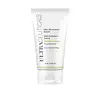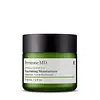What's inside
What's inside
 Key Ingredients
Key Ingredients

 Benefits
Benefits

 Concerns
Concerns

 Ingredients Side-by-side
Ingredients Side-by-side

Water
Skin ConditioningButyrospermum Parkii Butter
Skin ConditioningC12-15 Alkyl Benzoate
AntimicrobialGlycerin
HumectantMethylpropanediol
SolventGlyceryl Behenate
EmollientCyclopentasiloxane
EmollientCetyl Alcohol
EmollientGlyceryl Stearate
EmollientSodium Lactate
BufferingDimethicone
EmollientUrea
BufferingSodium Hyaluronate
HumectantCholesterol
EmollientLinoleic Acid
CleansingCeramide NP
Skin ConditioningLinolenic Acid
CleansingSodium PCA
HumectantTocopherol
AntioxidantHydroxyethyl Acrylate/Sodium Acryloyldimethyl Taurate Copolymer
Emulsion StabilisingPEG-75 Stearate
Xanthan Gum
EmulsifyingCeteth-20
CleansingSteareth-20
CleansingPolysorbate 60
EmulsifyingSorbitan Isostearate
EmulsifyingCocos Nucifera Oil
MaskingVanillin
MaskingPhenylpropanol
MaskingCaprylyl Glycol
EmollientDisodium EDTA
Sodium Hydroxide
BufferingLactic Acid
BufferingWater, Butyrospermum Parkii Butter, C12-15 Alkyl Benzoate, Glycerin, Methylpropanediol, Glyceryl Behenate, Cyclopentasiloxane, Cetyl Alcohol, Glyceryl Stearate, Sodium Lactate, Dimethicone, Urea, Sodium Hyaluronate, Cholesterol, Linoleic Acid, Ceramide NP, Linolenic Acid, Sodium PCA, Tocopherol, Hydroxyethyl Acrylate/Sodium Acryloyldimethyl Taurate Copolymer, PEG-75 Stearate, Xanthan Gum, Ceteth-20, Steareth-20, Polysorbate 60, Sorbitan Isostearate, Cocos Nucifera Oil, Vanillin, Phenylpropanol, Caprylyl Glycol, Disodium EDTA, Sodium Hydroxide, Lactic Acid
Water
Skin ConditioningCaprylic/Capric Triglyceride
MaskingPEG-8 Dimethicone
EmulsifyingGlycerin
HumectantDimethicone
EmollientSimmondsia Chinensis Seed Oil
EmollientCetyl Alcohol
EmollientGlyceryl Stearate
EmollientC12-15 Alkyl Benzoate
AntimicrobialButyrospermum Parkii Butter
Skin ConditioningEthoxydiglycol
HumectantSqualane
EmollientPalmitoyl Hexapeptide-12
Skin ConditioningPanthenol
Skin ConditioningEctoin
Skin ConditioningPhospholipids
Skin ConditioningHydrolyzed Sericin
Skin ConditioningAllantoin
Skin ConditioningXanthan Gum
EmulsifyingOlea Europaea Leaf Extract
PerfumingAloe Barbadensis Leaf Juice
Skin ConditioningStearyl Glycyrrhetinate
Skin ConditioningCeramide Ng
Skin ConditioningTocotrienols
Skin ConditioningTocopherol
AntioxidantAmmonium Acryloyldimethyltaurate/Vp Copolymer
PEG-75 Stearate
Benzyl Alcohol
PerfumingTribehenin
EmollientCeteth-20
CleansingSteareth-20
CleansingButylene Glycol
HumectantPEG-10 Rapeseed Sterol
CleansingElaeis Guineensis Oil
EmollientDehydroacetic Acid
PreservativeWater, Caprylic/Capric Triglyceride, PEG-8 Dimethicone, Glycerin, Dimethicone, Simmondsia Chinensis Seed Oil, Cetyl Alcohol, Glyceryl Stearate, C12-15 Alkyl Benzoate, Butyrospermum Parkii Butter, Ethoxydiglycol, Squalane, Palmitoyl Hexapeptide-12, Panthenol, Ectoin, Phospholipids, Hydrolyzed Sericin, Allantoin, Xanthan Gum, Olea Europaea Leaf Extract, Aloe Barbadensis Leaf Juice, Stearyl Glycyrrhetinate, Ceramide Ng, Tocotrienols, Tocopherol, Ammonium Acryloyldimethyltaurate/Vp Copolymer, PEG-75 Stearate, Benzyl Alcohol, Tribehenin, Ceteth-20, Steareth-20, Butylene Glycol, PEG-10 Rapeseed Sterol, Elaeis Guineensis Oil, Dehydroacetic Acid
 Reviews
Reviews

Ingredients Explained
These ingredients are found in both products.
Ingredients higher up in an ingredient list are typically present in a larger amount.
This ingredient is also known as shea butter. It is an effective skin hydrator and emollient.
Emollients help soothe and soften your skin. It does this by creating a protective film on your skin. This barrier helps trap moisture and keeps your skin hydrated. Emollients may be effective at treating dry or itchy skin.
Shea butter is rich in antioxidants. Antioxidants help fight free-radicals, or molecules that may harm the body. It is also full of fatty acids including stearic acid and linoleic acid. These acids help replenish the skin and keep skin moisturized.
While Shea Butter has an SPF rating of about 3-4, it is not a sunscreen replacement.
Shea butter may not be fungal acne safe. We recommend speaking with a professional if you have any concerns.
Learn more about Butyrospermum Parkii ButterC12-15 Alkyl Benzoate is made up of Benzoic Acid and long chain alcohols. It has a low molecular weight.
C12-15 Alkyl Benzoate is an emollient and texture enhancer. Due to its solubility, it is often used in sunscreens to help evenly distribute active ingredients.
As an emollient, C12-15 Alkyl Benzoate helps soften and hydrate your skin. Emollients create a film on your skin that traps moisture within.
This ingredient has been reported to cause eye irritation.
Learn more about C12-15 Alkyl BenzoateWe don't have a description for Ceteth-20 yet.
Cetyl Alcohol is a fatty alcohol. Fatty Alcohols are most often used as an emollient or to thicken a product.
Its main roles are:
Though it has "alcohol" in the name, it is not related to denatured alcohol or ethyl alcohol.
The FDA allows products labeled "alcohol-free" to have fatty alcohols.
Learn more about Cetyl AlcoholDimethicone is a type of synthetic silicone created from natural materials such as quartz.
What it does:
Dimethicone comes in different viscosities:
Depending on the viscosity, dimethicone has different properties.
Ingredients lists don't always show which type is used, so we recommend reaching out to the brand if you have questions about the viscosity.
This ingredient is unlikely to cause irritation because it does not get absorbed into skin. However, people with silicone allergies should be careful about using this ingredient.
Note: Dimethicone may contribute to pilling. This is because it is not oil or water soluble, so pilling may occur when layered with products. When mixed with heavy oils in a formula, the outcome is also quite greasy.
Learn more about DimethiconeGlycerin is already naturally found in your skin. It helps moisturize and protect your skin.
A study from 2016 found glycerin to be more effective as a humectant than AHAs and hyaluronic acid.
As a humectant, it helps the skin stay hydrated by pulling moisture to your skin. The low molecular weight of glycerin allows it to pull moisture into the deeper layers of your skin.
Hydrated skin improves your skin barrier; Your skin barrier helps protect against irritants and bacteria.
Glycerin has also been found to have antimicrobial and antiviral properties. Due to these properties, glycerin is often used in wound and burn treatments.
In cosmetics, glycerin is usually derived from plants such as soybean or palm. However, it can also be sourced from animals, such as tallow or animal fat.
This ingredient is organic, colorless, odorless, and non-toxic.
Glycerin is the name for this ingredient in American English. British English uses Glycerol/Glycerine.
Learn more about GlycerinGlyceryl Stearate is a mix of glycerin and stearic acid.
It is used to stabilize the mixing of water and oil ingredients. By preventing these ingredients from separating, it can help elongate shelf life. It can also help thicken the product's texture.
As an emollient, it helps soften skin and supports barrier-replenishing ingredients.
In cosmetics, Glyceryl Stearate is often made from vegetable oils or synthetically produced.
This ingredient may not be fungal-acne safe
Fun fact: The human body also creates Glyceryl Stearate naturally.
Learn more about Glyceryl StearatePEG-75 Stearate isn't fungal acne safe.
Steareth-20 is a waxy compound used to emulsify ingredients. It is created from stearyl alcohol.
It possesses surfactant properties. This means it reduces surface tension and helps oils, dirt, and pollutants to be washed away.
The 20 stands for the number of ethylene oxide used to create this ingredient.
Learn more about Steareth-20Tocopherol (also known as Vitamin E) is a common antioxidant used to help protect the skin from free-radicals and strengthen the skin barrier. It's also fat soluble - this means our skin is great at absorbing it.
Vitamin E also helps keep your natural skin lipids healthy. Your lipid skin barrier naturally consists of lipids, ceramides, and fatty acids. Vitamin E offers extra protection for your skin’s lipid barrier, keeping your skin healthy and nourished.
Another benefit is a bit of UV protection. Vitamin E helps reduce the damage caused by UVB rays. (It should not replace your sunscreen). Combining it with Vitamin C can decrease sunburned cells and hyperpigmentation after UV exposure.
You might have noticed Vitamin E + C often paired together. This is because it is great at stabilizing Vitamin C. Using the two together helps increase the effectiveness of both ingredients.
There are often claims that Vitamin E can reduce/prevent scarring, but these claims haven't been confirmed by scientific research.
Learn more about TocopherolWater. It's the most common cosmetic ingredient of all. You'll usually see it at the top of ingredient lists, meaning that it makes up the largest part of the product.
So why is it so popular? Water most often acts as a solvent - this means that it helps dissolve other ingredients into the formulation.
You'll also recognize water as that liquid we all need to stay alive. If you see this, drink a glass of water. Stay hydrated!
Learn more about WaterXanthan gum is used as a stabilizer and thickener within cosmetic products. It helps give products a sticky, thick feeling - preventing them from being too runny.
On the technical side of things, xanthan gum is a polysaccharide - a combination consisting of multiple sugar molecules bonded together.
Xanthan gum is a pretty common and great ingredient. It is a natural, non-toxic, non-irritating ingredient that is also commonly used in food products.
Learn more about Xanthan Gum